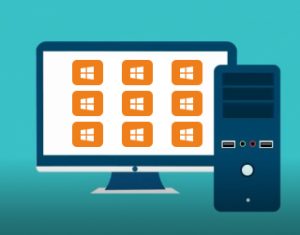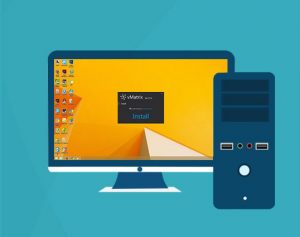How to Set Up the vCloudPoint VDI System
Installing or managing a VDI system requires the IT staff to be knowledgeable of or experienced in the virtualization platform.
-
1. Virtualize the server to get virtual machines
(Refer to the instructions of the specific virtualization software used)

-
2. Install Virspire on each virtual machine
(You can use pre-install VM template or run commands for centralized installation)

-
3. Connect the zero clients and you are ready to work
(The connection of the zero clients is exactly the same as PCs)

More about the vCloudPoint VDI Solution
-
How does Microsoft license the Windows desktop for virtual environments?
What kind of Microsoft license should I purchase for using the Windows desktop in virtual environments?
The license you should purchase for virtual environment depends on the type of Windows OS you use within a VM.
- Running a Windows Server OS within a VM: (1 VM for multiple users)
Besides the standard server OS licenses based on the actual number used, each vCloudPoint zero clients will need a Remote Desktop Services Client Access License (RDS CAL) along with a Windows Server Client Access License (WS CAL).
- Running a Windows Client OS within a VM: (1 VM for 1 user)
Besides the standard Client OS licenses based on the actual number used, each vCloudPoint zero clients will need a Windows Virtual Desktop Access (VDA) in order to access a Windows VDI desktop.
What is Windows Server Client Access Licenses (WS CALs)
A Windows Server CAL is a license that allows customers to access Windows Server. CALs are used in conjunction with Microsoft Windows Server OS licenses to allow Users and/or Devices to access and utilize the services of that server OS.What is Remote Desktop Service Client Access Licenses (RDS CALs)
RDS CALS are required for users or devices that want to utilize Remote Desktop Service functionality on Windows Server.
About the version of CALs
Windows Server CALs must be the same version as—or higher than—the server OS they are accessing. In other words, users or devices accessing a server running Windows Server 2016 must have Windows Server 2016 CALs. Additionally, Windows Server 2016 CALs may be used to access Windows Server 2012 (but Windows Server 2012 CALs cannot be used to access Windows Server 2016).
What is Windows Virtual Desktop Access (VDA)?
Windows VDA is a device based subscription designed to help organizations license devices that do not qualify for Windows Client SA, such as thin clients and contractor-owned PCs, so these devices can access a virtual desktop. Windows VDA is available for $100 / year/ device through all major Microsoft Volume Licensing (VL) programs.
Pricing is retail pricing in USD, and prices may vary depending on your location and agreement with Microsoft. Microsoft reserves the right to change prices at any time.The result of the licensing model differences by a 30-user deployment using 1 VM with server OS for 30 users, 30 VMs with client OS for 30 users, and 5 VMs with client OS for 5 users + 1 VM with server OS for 25 users, over 3 years can be seen in the following example:
1 VM with server OS for 30 users: 1 server OS license for each VM ($883) + For each client device: ( 1 Server device CAL ($30) and 1 RDS device CAL ($102) x 30 = $883x 1 + $132 x 30 = $4,843
30 VMs with client OS for 30 users: 30 target desktop OS licenses ($187 each) x 30 + For each client device: VDA rights subscription ($100 / device / year) x 30 devices x 3 years = $14,610
5 VMs with client OS for 5 users + 1 VM with server OS for 25 users: 5 target desktop OS licenses ($187 each) x 5 + For each client device: VDA rights subscription ($100 / device / year) x 5 devices x 3 years + 1 server OS license ($883) + For each client device: ( 1 Server device CAL ($30) and 1 RDS device CAL ($102) x 25 = $187x 5 + $100x 5x 3+ $883x 1 + $132 x 25 = $6618
* Cost based on 30 zero clients (not eligible for SA) over 3 years, Windows Server 2012 R2 standard, Windows 8.1 Pro, US VOL pricing, corporate customers.
Note: you cannot purchase Windows VDA outright. It is only available as a subscription.
While deploying zero clients from vCloudPoint, the required licenses mentioned above must be purchased from Microsoft. It is significant to note that Microsoft’s license policy varies between countries and vCloudPoint users are requested to refer to their local Microsoft’s partners before purchase.
For further details on Microsoft’s licensing for virtual environments please refer to Microsoft’s website or licensing documents: “VDA_Brochure” and “Microsoft VDI and VDA FAQ v3 0“.
What languages does the software support?The languages that the vMatrix Server Manager software and the zero client support include Simplified Chinese, English, Spanish, Portuguese, Turkish, Russian, Polish, Slovak, Korean and Persian. JoinVDI Virtualization Manager supports Simplified Chinese, English, Czech, Spanish, French, Italy, Japanese, Korean, Portuguese, German. Virspire Desktop Agent does not provide a management console while the installation interface provides English and Simplified Chinese displayed according to the system. The default language for the server-side software is the system language. The default language for the zero client is English and users can change its language at the display menu of the login interface. More languages will be added with future updates.
What are the limitations of the VDI solution?1, VDI is a highly flexible and manageable desktop computing solution but it is much more complex when compared to a traditional PC solution. Before making the purchase decision, customers shall have a thorough estimation of the overall costs and make sure you have skillful IT staff to manage the virtual desktop infrastructure.
2, vCloudPoint zero clients support conventional USB devices such as printers, scanners, storage devices, etc. When working in the VDI environment with Virspire, the zero clients are supposed to support most types of USB peripherals as working on a PC, except for webcams. If you need to use a typical USB device on the zero clients, please consult us before purchase.
3, The vCloudPoint solutions require a reliable and low latency local network. Wireless LAN or WAN connection is recommended for individual and occasional use only, as a poor network connection will cause unexpected disconnection and compromised experience.
4, Centralized computing may cause a one-down-all-down issue. If your use case is sensitive about immediate access, make sure you have a fail-over configuration during deployment. VM migration and failover are features available in most virtualization solutions.
